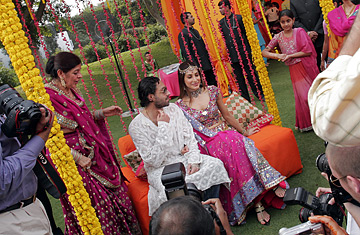
A lavish wedding in New Delhi
Simran Kaur got married last December in what she terms a "medium-sized Punjabi wedding". "There were only a thousand guests," she says amidst the colour, bling and music of her wedding video. "And the four days of ceremonies before the wedding were attended by only relatives and close family friends," says the 26-year-old homemaker from Chandigarh, the capital of the prosperous state of Punjab, adding, not without a hint of irony, "which made up some 250 people."
Weddings have always been extravagant affairs in India, festivities lasting up to a week or more. Now, with the economy growing at over 9% and the ranks of the middle class swelling to nearly 300 million, weddings are becoming the most conspicuous examples of conspicuous consumption. Besides ceremonies and feasts, even dowries — legally outlawed — are becoming larger and more costly.
"Post liberalization of the economy in the '90s, a new mind-set has evolved," says sociologist Patricia Oberoi. "The socialist inhibitions of old have gone, and there is encouragement from private interests, and by default from the government, to spend more. Weddings are the bread and butter of bridal fairs and magazines, and of the fashion and event management industries."
Oberoi adds that the large and mostly prosperous Indian diaspora fuels this craze. "For them it is an issue of self-esteem and community sentiment," she says of the 20 million Indians settled abroad, or Non-Resident Indians (NRIs), as they are known. "In the southern state of Tamil Nadu, for instance, dowry has ceased to be a demand," she says. "But the groom's side insist that the wedding be a spectacular affair."
Mumbai wedding planner Parthip Thyagarajan says it is not unheard of for families to spend as much as $500,000 on a wedding. "There's only a small percentage of people who spend such crazy amounts on weddings — probably just 10% of the wealthy Indians," he says, "but they are highly visible. Think Sant Singh Chatwal."
Chatwal is an Indian-American Sikh businessman whose son's profligate wedding in Delhi last year became the subject of a Discovery Channel documentary, The Great Indian Wedding.The flood of over-the-top weddings that followed in its wake — mostly within Delhi's Sikh community — eventually prompted the Delhi Sikh Gurdwara Management Committee, a communal organization that maintains temples and represents nearly half of the city's Sikh population, passing an injunction requiring that all Sikh weddings in Delhi must now take place in gurdwaras,as Sikh temples are known, and not in hotels. No liquor or meat is to be served, according to the injunction, and the ceremony must be wrapped up before noon.
"Profligacy is against the tenets of our religion," says Paramjit Singh Sarna, the president of the Delhi Sikh Gurdwara Management Committee. "Sikhism aims at doing away with meaningless social customs," he says, "but spending huge amounts on weddings creates serious social evils like female foeticide and infanticide."
The murder of female babies has been a persistent malaise in north-western India, and recent studies have shown that it is spreading to other parts of the country, too. "When people see how much they have to spend on marrying off a daughter, they prefer to not have daughters," says Oberoi. "If not killed, girls are often neglected in the family."
In the Kashmir Valley, weddings have become so prohibitively expensive that many women are forced to remain single if their parents are not well-to-do. "There are some 40,000 women over the age of 40 who have not been able to marry because their parents could not afford a traditional wedding," says Dr. Ihsan-ul-Haq, who set up a "marriage counseling cell" under the aegis of the Islamic Dawaa Centre to convince young people to opt for simpler, less expensive weddings.
Haq says Kashmiri weddings comprise an almost month-long cycle of feasts and exchange of gifts between the bride's and the groom's family. "Each side tries to outdo the other in the amount and value of gifts they offer," he says, "and this is considered to have become an unquestionable custom." His organization's members have committed to spending $1,250 or less on their wedding, and to hold "simple and austere" weddings in accordance with Shariah law, he says.
Will such initiatives succeed in trimming the big, fat Indian wedding? Not any time soon, says Thyagarajan. But, he adds, "As people become more educated and progressive, they will begin to see the absurdity of spending $5,000 on a wedding dress. Given that more and more marriages are failing, people will soon stop making a big deal of it."
